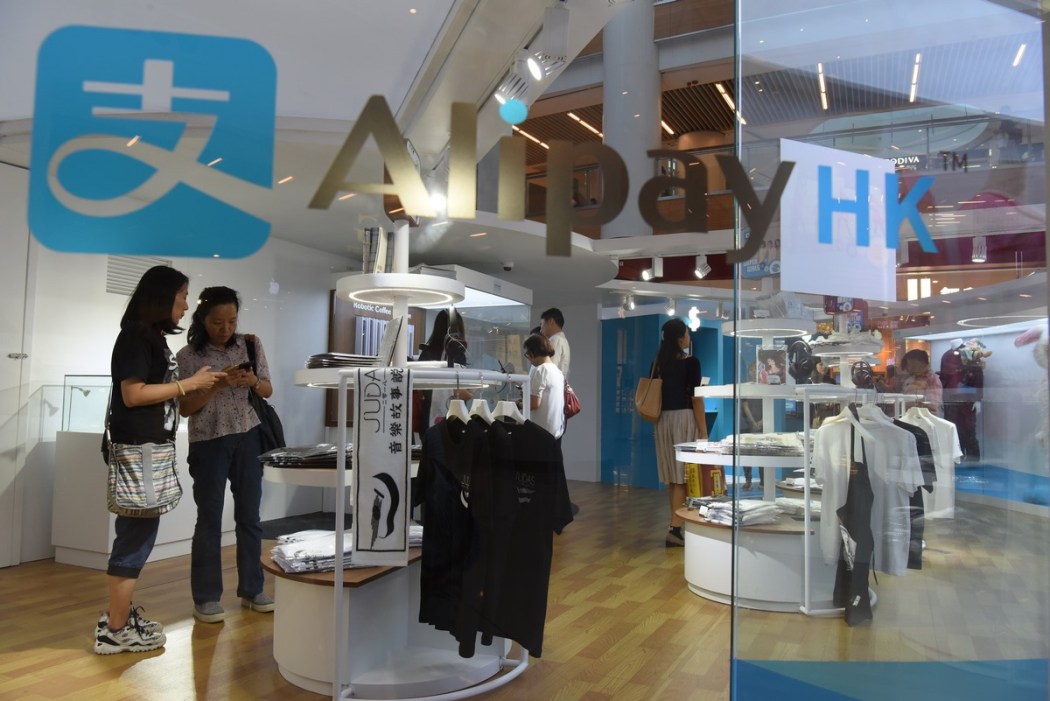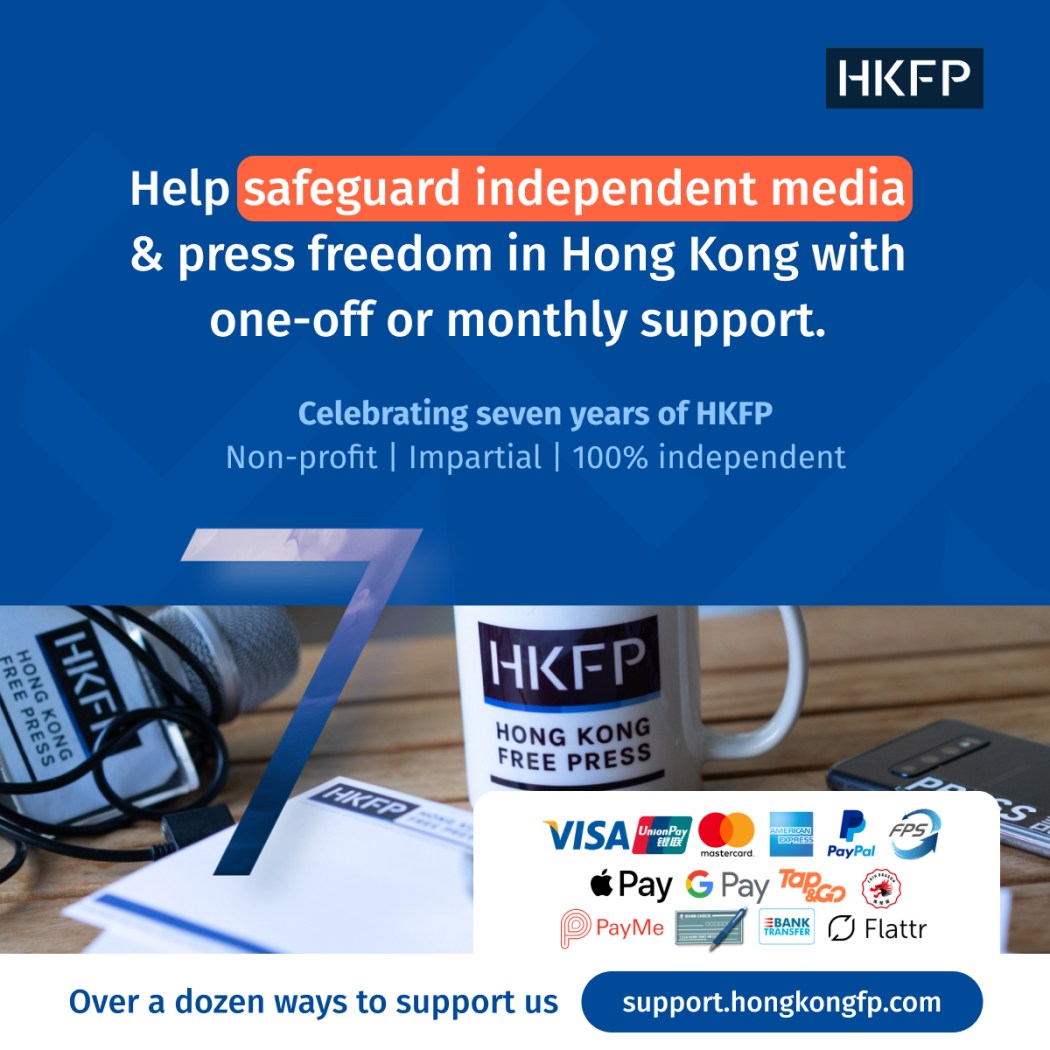How China’s Alipay and WeChat Pay became the most popular e-payment apps in Hong Kong
Hong Kong has long been a city that relies largely on cash, credit cards and Octopus. When it launched in 1997, it was only the second contactless payment system in the world after South Korea’s Upass.
However, the government’s announcement in 2021 that it would disburse consumption vouchers through digital payment methods has led to a boom in the use of payment apps – with Chinese platforms like Alipay HK and WeChat Pay HK emerging as clear leaders in the field.
The two apps were already popular within certain sections of society, including mainland Chinese students studying in Hong Kong or business owners who needed to work in the mainland. But now, you can expect to see QR codes inviting you to pay using Alipay HK or WeChat Pay HK whenever you enter a restaurant in the city.
HKFP delved into the public data released by the companies, while speaking to young Hongkongers about their views on the apps, to find out how these Chinese platforms managed to succeed in a city where businesses with ties across the border were once boycotted by pro-democracy protesters.
Most popular apps
The Hong Kong government rolled out the first round of consumption vouchers – HK$5,000 for each eligible resident – to boost the local economy amid the Covid-19 pandemic in 2021. It required Hong Kong residents to collect their handouts using four designated e-payment platforms: Alipay HK, WeChat Pay HK, Tap & Go and Octopus card.
Alipay HK, which is a subsidiary of mainland Chinese multinational Alibaba Group’s Alipay, was established in 2017 and later held by affiliate company Ant Group. For Hong Kong customers who do not have a bank account in mainland China, it is the only way to pay for goods on Taobao, China’s biggest online shopping platform.
Tencent’s WeChat Pay HK, launched in 2018, is the electronic wallet for Hong Kong users of Chinese instant messenger app WeChat, and it supports cross-border transactions between Hong Kong and the mainland.
As of 2022 and 2023, Alipay HK and WeChat Pay HK have each accumulated five million registered users, according to Alipay HK and a Tencent spokesperson. This means that approximately 67 per cent of residents have signed up for these platforms, although some users may be double-registered or tourists.

The main rival to Alipay HK and WeChat Pay HK is the local digital wallet Tap & Go developed by Hong Kong Telecom, one of the largest local telecommunications companies in the city, in 2015. Instead of offering QR code payment services like Alipay HK and WeChat Pay HK, Tap & Go can be used as a virtual debit card that supports contactless transactions. However, the local payment method had only garnered around 3.6 million users in 2022, as stated it its annual results announcement.
With two more rounds of consumption vouchers released in 2022 and 2023, two more payment tools – Bank of China’s BoC Pay and HSBC’s PayMe – were added to the list. They mostly support transactions between users rather than those between users and merchants. Seeing much slower growth in the number of users, they pose little threat to the dominance of the Chinese payment tools.
In contrast, Alipay HK and WeChat Pay HK have fully developed user-to-user and user-to-merchant payment services, and have prevailed in terms of the number of merchants. As of February, Alipay HK claimed to cover 90 percent of Hong Kong shops, according to Liang Yijian, head of Ant Financial Services’ international business in Hong Kong.

WeChat Pay HK said it had experienced significant growth since becoming one of the selected payment tools for consumption vouchers, with an annual increase of 30 per cent in commercial transactions. It currently covers over 150,000 merchants across Hong Kong, while Tap & Go’s website states that it covers approximately 100,000 merchants. No information regarding business coverage has been disclosed by the other payment apps.
A matter of politics?
The battle for popularity among Hong Kong’s payment apps has not always been a foregone conclusion.
As a young pro-democracy Hongkonger, 24-year-old Stephanie Ma made a rare decision among her peers – opting for Alipay HK as the tool to collect her consumption vouchers.
“I have friends who protested during 2019 and used to be reluctant to use Taobao, but they began using Alipay,” Ma, who works in the fashion industry, told HKFP.
“I know a lot people were saying that we shouldn’t use Chinese apps, but I was tight on money back then, and all I could think about was how to spend my handout in the best way possible – the answer was to collect it with Alipay,” she said, adding that the app was accepted by most businesses, and had fewer restrictions compared to the Octopus card.

Alipay HK has been expanding its services since it started providing payment services on the MTR, bus, and minibus services in 2021, the same year the first consumption voucher was announced.
Alipay HK’s user base grew by over 150 per cent after the service expansion, and Venetia Lee, its chief executive, said the number of small-and-medium-sized merchants that accept Alipay HK payment increased by 230 per cent over the past two years. The Chinese app was also the second most popular method to collect the first consumption voucher, following the Octopus card, according to Hong Kong’s finance chief Paul Chan.
Ma told HKFP she had installed Alipay HK while at university, but the app only began to penetrate her daily life after the release of the consumption voucher.
“I have been using it quite frequently since then, to pay my transport fees and buying products offline… it has almost replaced my Octopus card,” Ma said, adding that she was not the only one who has experienced this transformation of her spending habits.
A survey conducted by Hong Kong’s Lingnan University revealed that 63 per cent of the 6,154 respondents surveyed had increased their usage of digital wallets since the launch of the consumption voucher scheme.
Ma, who recently travelled to mainland China with her boyfriend, was impressed by the app’s integration with the mainland’s QR code-based payment ecosystem. “It’s crazy how convenient it was using Alipay in the mainland – no one uses cash there,” she said.
However, Ma said that, as a self-proclaimed pro-democracy Hongkonger, she felt awkward posting about her Alipay usage on social media, as it was against the norms of the “yellow economic circle” – a consumer movement that was a product of the protests of 2019.
She later found out that some of her friends shared the same thoughts about using Alipay HK. “I confess that I have been using the app only if a friend brings up the topic first,” she said.
Deliberate financial decision
The idea of the “yellow economic circle” emerged three years ago when Hong Kong was gripped by mass street protests against a proposed amendment to its extradition bill. Pro-democracy Hongkongers rallied to support like-minded businesses and to boycott pro-government ones, or those with ties to mainland China – Alipay HK and WeChat Pay HK among them.

According to Tap & Go’s parent company, half of the app’s users were aged between 18 to 29 years old. Neither Alipay HK nor WeChat Pay HK published such statistics.
HKFP has reached out to Alipay HK, WeChat Pay HK and Tap & Go for comment.
Kin, 27, a secondary school teacher with a keen interest in personal finance, was not among them. Instead, he opted for WeChat Pay HK to collect his consumption vouchers.
Despite being a recent addition to the payment app market, WeChat Pay HK has acquired 5 million users in just five years. Most payment apps were launched one to three years before WeChat Pay HK, yet were not able to not garner as many users.
A significant factor behind its remarkable growth was – in Kin’s words – “WeChat Pay HK simply offered the highest bonus.”

Users who chose the Chinese digital wallet as the voucher collection tool were eligible to enter an online lottery for cash bonuses. Kin bagged HK$400 in the lottery.
While Ma considered using a Chinese payment apps an unspeakable secret, Kin said he saw it as a deliberate financial decision unrelated to any political stance.
“I have been transferring money from my credit cards to these apps, then transferring it back to my bank account. I can earn credit card rewards through this practice, but the apps are the ones paying the handling fee for me, “ he explained.
According to Kin, Alipay HK and WeChat Pay HK offered more competitive discounts and had more stable systems than Tap & Go and Octopus cards, and he considered convenience and discounts the most important factors when choosing a payment app. He said he did not start using WeChat Pay more often after the voucher collection.

Although Ma and Kin both agreed that they were not in the majority of young Hong Kong people, they thought it was obvious that the trend of Chinese-style QR code-based payment methods was growing.
When asked how they would feel if Hong Kong were fully integrated into China’s payment ecosystem, Ma said using Alipay HK had made her more open to mainland Chinese technology and culture. She added that people who used the apps had begun to focus less on current affairs and more on the financial perks and entertainment offered by Chinese apps and social media, such as Xiahongshu, a Chinese e-commerce platform that is gaining momentum in the Hong Kong market .
“Still, the integration of China and Hong Kong does not result from the usage of these apps, it’s more like… I don’t know what I can do as a Hongkonger who supports democracy anyway,” Ma said, adding that she did not see how boycotting Chinese apps would make a significant difference to the political development of the city.
“After all, the apps themselves are just neutral tools,” she said.
Support HKFP | Code of Ethics | Error/typo? | Contact Us | Newsletter | Transparency & Annual Report





:quality(70)/cloudfront-eu-central-1.images.arcpublishing.com/irishtimes/SL4ZJEXTC5DIXNN4OZFLJTU4UE.jpg)


